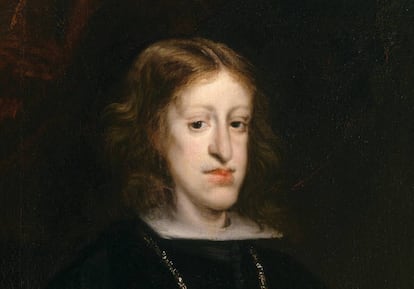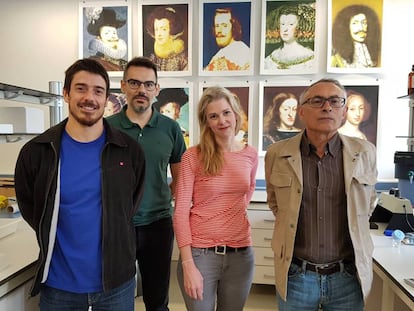Research confirms that intermarrying caused the ¡®Habsburg jaw¡¯ in Spanish royals
After analyzing portraits, a team of geneticists and surgeons has confirmed the link between the diplomatic strategy adopted by the dynasty and their prevalent overbite

According to historian Jaime Contreras, the birth of Charles II of Spain on November 6, 1661, was used as an excuse to organize a huge party in Madrid, complete with extravagant costumes in the shape of animals and demons. ¡°Hundreds of astrologers made predictions,¡± he wrote in his book Charles II, The Bewitched. ¡°The best known predicted that the prince would become king. Most of the astrological charts supported it: Saturn was the planet that sent the strongest message, a star was found on the horizon of the Spanish court without a malicious aspect.¡± All too soon, however, the predictions would be proven wrong.
The team has based its diagnosis of the Habsburgs¡¯ facial deformity on 66 portraits
Charles II, the last Habsburg ruler of the Spanish Empire, was sick from birth. He became king aged four, when he was a child with rickets and epilepsy and was still feeding at his mother¡¯s breast. Francesco Niccolini, the Apostolic Nuncio to Portugal, described the 25-year-old king as ¡°short rather than tall, not badly formed, ugly of face; he has a long neck, a long face that curves inwards; the lower lip typical of the House of Austria [also known as the House of Habsburg]¡ He can¡¯t straighten his body, rather when he walks he curls up against a wall, a table or something else. His body is as weak as his mind. Occasionally, he shows some intelligence, memory or liveliness but not now; in general he has a slow and indifferent demeanor, clumsy and indolent, appearing stupefied. One can do what they like with him, as he lacks his own will.¡±
Geneticist Francisco Ceballos points to an oil painting of Charles II with his jutting jaw, painted by Juan Carre?o de Miranda around 1680. ¡°It¡¯s not just the underbite,¡± he says. ¡°Charles II had a drooping nose, eyes, and cheeks. He had a deficient jawbone and his whole face fell.¡±
Ceballos is one of 14 scientists who have just established a direct link between this facial deformity characteristic of the Spanish Habsburgs and the intermarrying that was carried out for almost two centuries.
Charles II¡¯s parents, Philip IV and Mariana of Austria, were uncle and niece. ¡°But with the consanguinity accumulated over the generations, it was as if they were siblings, like incest,¡± says Ceballos, who works at Witwatersrand University in Johannesburg. He adds that Charles II was the result of the Habsburg strategy for diplomacy, summed up by the Latin phrase ¡°Bella gerant alii, tu felix Austria nube¡± ¨C meaning, ¡°Let others wage war; but thou, O happy Austria, marry.¡± Marriages between members of different reigning families, with sex between cousins and uncles and nieces, meant the Habsburgs ruled a significant part of Europe.

A team of 10 maxillofacial surgeons has based its diagnosis of the Habsburgs¡¯ facial deformity on 66 portraits predominantly from the Prado art museum in Madrid and Vienna¡¯s Museum of the History of Art, from Philip I (1478-1505) to Charles II (1661-1700). The researchers have calculated the degree of underbite and jawbone deficiency and have confirmed what has long been suspected ¨C ¡°an association between the facial deformity and endogamy¡± with the disfigurement worsening, the closer the kinship between the parents. The study has been in the journal, The Annals of Human Biology.
Florencio Monje, president of the Spanish Society for Oral, Jaw, Head and Neck Surgery, directed the findings, which were also backed up by historical documents.
Monje mentions the description of King Charles V by his cosmographer Alonso de Santa Cruz: ¡°His ugliest feature was his mouth, because his teeth were so ill proportioned with those above that they would never meet.¡± De Santa Cruz went on to mention how this handicapped both his speech and his ability to easily chew food.
The kings and queens are a laboratory to study the effect of human inbreeding
Geneticist Francisco Ceballos
¡°Consanguinity is an entry point for becoming acquainted with the genetic architecture of a feature,¡± says Ceballos, who goes on to explain that one person receives two versions of each gene, one from the mother and the other from the father. These two pairs can be different, in which case the dominant one will be apparent, masking the information belonging to the other recessive gene. In the case of the Spanish Habsburgs all the evidence suggests that the jutting jaw was a recessive feature that emerged in the royals as their inbreeding increased the possibility of inheriting two equally defective pairs.
Ceballos and geneticist Gonzalo ?lvarez from the Santiago de Compostela University have spent more than a decade analyzing the House of Habsburg. In 2009, they flagged up two genetic disorders ¨C the deficiency of pituitary hormones and distal renal tubular acidosis ¨C as the main causes of Charles II¡¯s terrible health, including infertility, which led to the end of the family line. Scientists have studied a family tree containing 6,000 members from 20 generations of the Habsburgs. If Philip I¡¯s ratio of consanguinity was 0.025, by the time Charles II was born, the ratio had soared to 0.25, meaning that 25% of his genes were repeated, having received the same copy from both parents.
¡°The kings and queens are a laboratory for studying the effects of human inbreeding,¡± says Ceballos, who is currently studying the House of Bourbon in order to expand his research.
¡°King Alfonso XIII [the great-grandfather of Spain¡¯s ruling King Felipe VI] had a clear underbite,¡± says Monje who in 2016 published the book The Sick Face: 50 Universal Paintings to Understand Face and Neck Illnesses.
¡°This new work on the ¡®Habsburg jaw¡¯ suggests a pattern of recessive inheritance,¡± says Georgina Martin¨®n Torres, a geriatrician at Ciudad Real¡¯s General University Hospital, not involved with the research, who wrote her doctoral thesis on old age in the work of Spanish artist Diego Vel¨¢zquez. In her opinion, genomic analysis of people with underbites would be needed to confirm this.
English version by Heather Galloway.
Tu suscripci¨®n se est¨¢ usando en otro dispositivo
?Quieres a?adir otro usuario a tu suscripci¨®n?
Si contin¨²as leyendo en este dispositivo, no se podr¨¢ leer en el otro.
FlechaTu suscripci¨®n se est¨¢ usando en otro dispositivo y solo puedes acceder a EL PA?S desde un dispositivo a la vez.
Si quieres compartir tu cuenta, cambia tu suscripci¨®n a la modalidad Premium, as¨ª podr¨¢s a?adir otro usuario. Cada uno acceder¨¢ con su propia cuenta de email, lo que os permitir¨¢ personalizar vuestra experiencia en EL PA?S.
En el caso de no saber qui¨¦n est¨¢ usando tu cuenta, te recomendamos cambiar tu contrase?a aqu¨ª.
Si decides continuar compartiendo tu cuenta, este mensaje se mostrar¨¢ en tu dispositivo y en el de la otra persona que est¨¢ usando tu cuenta de forma indefinida, afectando a tu experiencia de lectura. Puedes consultar aqu¨ª los t¨¦rminos y condiciones de la suscripci¨®n digital.











































